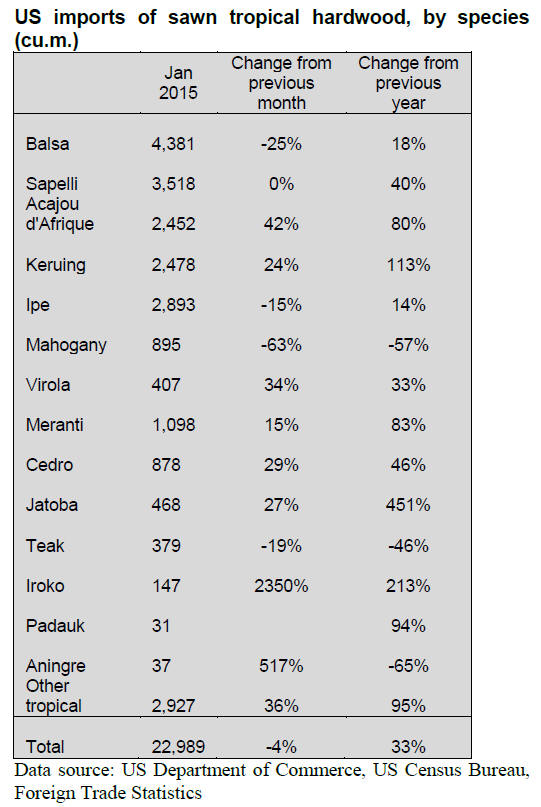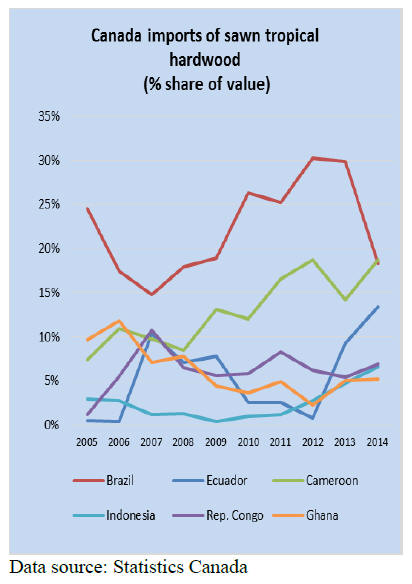|
Report from
North America
Increased imports of acajou d¡¯Afrique, keruing and
meranti
Tropical sawnwood imports declined 4% month-on-month
in January to 22,989 cu.m. However, despite the overall
decline in imports, shipments from Cameroon and
Malaysia to the US market increased.
Imports from Cameroon were up 42% from the previous
month (4,124 cu.m.). Sapelli imports from Cameroon
reached 2,259 cu.m., while acajou d‟Afrique imports were
1,479 cu.m. Malaysian shipments to the US increased by
24% from December (2,978 cu.m.).
Imports from most other tropical sawnwood suppliers
declined in January, including Brazil (3,686 cu.m.),
Congo/Brazzaville (1,153 cu.m.), Indonesia (943 cu.m.)
and Ghana (815 cu.m).
Balsa imports from Ecuador fell by one quarter in January
to 4,381 cu.m. On the other hand sapelli imports remained
unchanged from the previous month at 3,518 cu.m.
Imports of ipe were 2,893 cu.m. (-15%), while imports of
acajou d‟Afrique and keruing increased in January to
2,452 cu.m. and 2,478 cu.m., respectively.

Higher Canadian sapelli imports
Canadian imports of tropical sawn hardwood were valued
at US$1.25 million in January, up one third from
December but total imports are only half the value seen
last summer. Africa remains the largest source of imports
for Canada, followed by South America (mainly balsa)
and then Asia.
Balsa imports from Ecuador were worth US$296,183 in
January. The second-largest source of hardwood imports
was Cameroon at US$208,387, although the value of
imports fell from December.
January imports from Indonesia declined slightly from
December, but at US$182,700, they were higher than in
January 2014.
In January the value of sapelli sawnwood imports by
Canada increased by 18% from the previous month to
US$357,500. Imports of mahogany were worth
US$55,3400 and the combined value of virola, imbuia and
balsa imports amounted to US$312,600.
Growth in Africa¡¯s share of sawnwood imports
US Imports of tropical sawnwood plummeted in the years
the market share of the main suppliers fluctuated widely
from then on. Overall, Brazil remained the largest supplier
to the US but Canada has imported slightly more from
Cameroon than from Brazil recently.
Cameroon gained a significant import share in Canada at
close to 20% based on the value of imports in current US
dollars with much of the growth being in sapelli
sawnwood shipments. Cameroon also gained market share
in the US, but the growth was slower.
Of sawnwood imports from Asia, Malaysia is the primary
supplier to the US while Canada imports mainly from
Indonesia. US imports from Indonesia have declined since
2005 although the import share has increased to 4% since
the end of the recession. Malaysian sawn hardwood
shipments to the US have been very stable over the past
ten years.
In both the US and Canada the share of imports from
Africa has increased over the last ten year, while South
America‟s imports share declined. South American
countries‟ share in US imports fell from approximately
56% in 2005 to below 50% in 2014. During the same
period Africa‟s share increased by about ten percentage
points to 26%.
In Canada the trend was similar, although African supplier
countries always had a higher share in imports than in the
US. Southeast Asia‟s import share in the US market
remained relatively unchanged around 20% in the last ten
years.
 
New US homes increasingly ¡°green¡±
The US National Association of Home Builders reports
that more and more home buyers are looking for
sustainable features in homes, higher energy efficiency
and renewable energy facilities such as geothermal heat
pumps and solar panels.
Energy Star certifications are a priority for young home
buyers. Builders are responding to the demand and build
more green single and multi-family homes. Home buyers
are also concerned about indoor air quality, sustainable
materials and products, and locally manufactured
products.
|